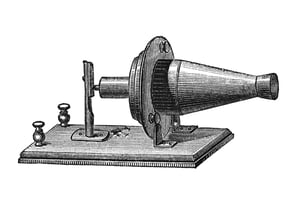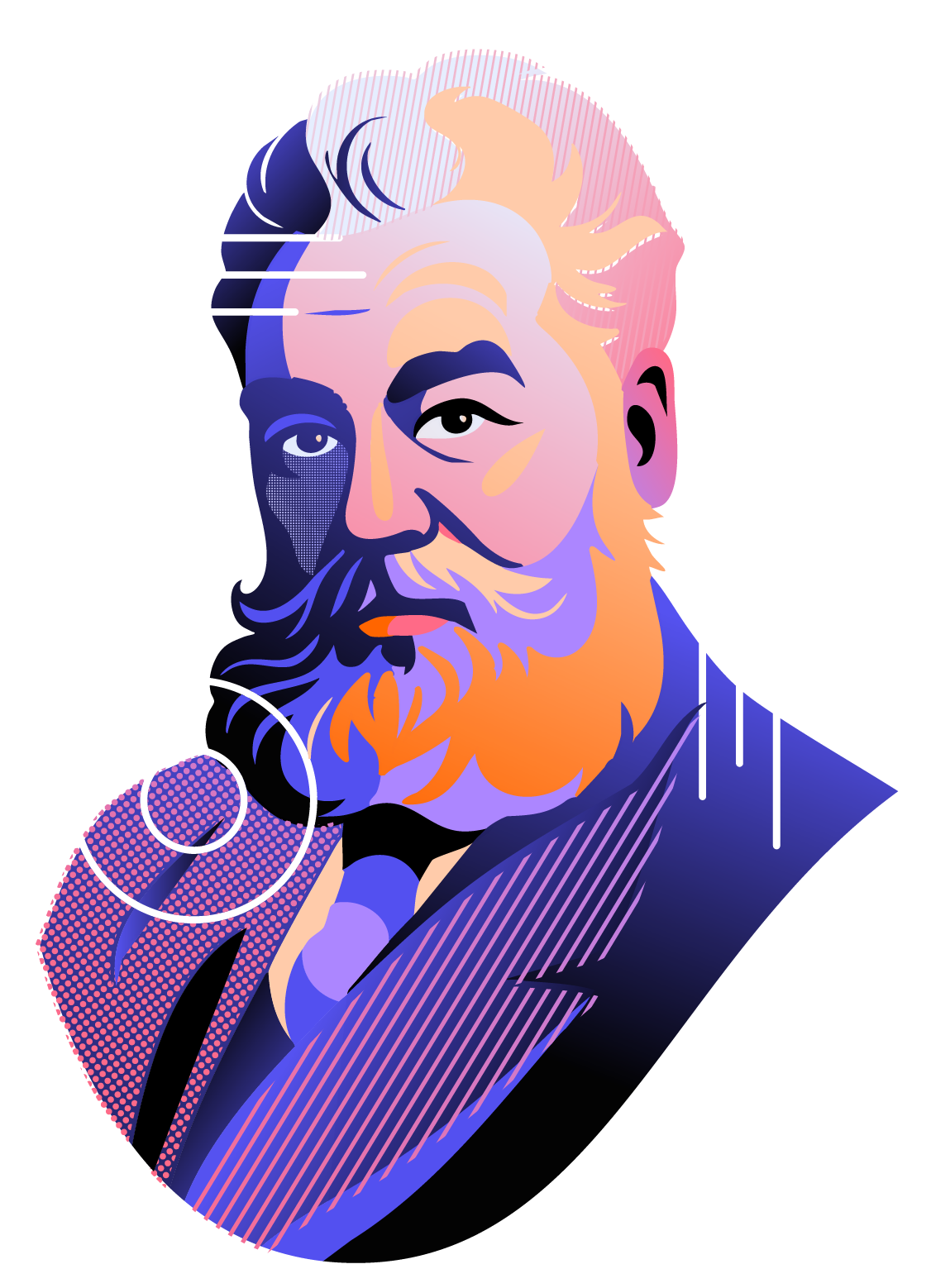
Alexander
Graham Bell
1847 - 1922
Welcome to our Game Changers.
The world moves forward because of game changers, those who see possibilities where others see limits. Across every industry, innovative organizations are transforming the way we live.
Hello?...Is Anyone There?
Long before phones were digital portals to the entire world nominally used to actually talk to other people live, a marvel that would kick it all off would be invented by a talented scientist and engineer who from a very young age was called to greatness.
Born Alexander “Aleck” Bell, he always wanted a middle name like his two other brothers, so, on his 11th birthday, his father allowed him to adopt the middle name “Graham,” chosen out of respect for Alexander Graham, a Canadian being treated by his father who was also a family friend. Like many inventors, Bell expressed great curiosity as a child and quickly began tinkering away. At the age of 12 he built a homemade device that combined rotating paddles with sets of nail brushes, creating a simple dehusking machine that was put into operation at the mill his best friend’s family owned and operated and was used steadily for a number of years.
In addition to being an inventor, early in his life he expressed interest and great talent for art, poetry, and music that his mother encouraged. Though he had no formal training, he mastered the piano and became the family’s pianist. He also dabbled “voice tricks,” similar to ventriloquism, that he used to entertain family guests.
When Bell was 12 years old, his mother began losing her hearing and this greatly affected him and would inspire his work on the first telephone. He learned a finger language so that he could sit at her side and tap out conversations that were being had around the house. He also developed a technique of speaking in clear, modulated tones directly into his mother's forehead, which let her hear him with reasonable clarity.
After losing his brother to tuberculosis, Bell travelled to Ontario Canada with his parents and his brother’s widow in 1870, at the age of 23, where they settled on a 10.5 acre homestead near Brantford, Ontario. Bell setup his workshop in the old carriage house to continue innovating. Inspired by his mother, Bell continued to work with deaf people and later would teach a visible speech system created by his father, that the two taught to numerous instructors at schools for the deaf across the Canada and the US. Bell’s contributions and dedication to the deaf to help them be widely accepted and integrated into society were unmatched. His most famous pupil was Helen Keller.
In 1872, Bell became professor of Vocal Physiology and Elocution at the Boston University School of Oratory. He taught classes by day and conducted research in sound and experiments by night. He endeavoured to find a way to transmit musical notes and articulate speech.
And he answered the call.
By 1874, Bell’s work on the harmonic telegraph had reached it’s formidable stage. However, with lack of funding and resources, he found furthering his research and establishing a functioning prototype to be challenging. Through a series of fortuitous events, partners, and patent filing timing, on March 10, 1876, Bell got his telephone to work. He muttered the famous words into his telephone to his business partner Thomas A. Watson who was on a telephone in the same building, but out of earshot, “Mr. Watson, come here – I want to see you" and Watson soon appeared at his side.
Bell and his partners, Hubbard and Sanders, offered to sell the patent outright to Western Union for $100,000, equal to $2,952,813 today, but a deal wasn’t reached because reportedly, the president of Western Union proclaimed the telephone was nothing but a toy. Two years later he lamented that getting that patent for $25 million would’ve been a bargain. At this point Bell and his partners were no longer interested in selling it.
The Bell Telephone Company was created in 1877, and by 1886, more than 150,000 people in the U.S. owned telephones. Bell was served with multiple patent lawsuits many of which went to the Supreme Court, where his patents were ultimately upheld. The strain of these legal matters caused him to resign from the Bell Telephone Company in 1880.
He went on to continue innovating and started a family. Some of his notable inventions following the telephone were, the PhotoPhone (a wireless telephone), metal detector, hydrofoils and hydroplanes, and aeronautics inventions such as high powered motor airplanes. He also continued his medical research and research on ways to help the deaf learn to communicate.
During his time at Volta Laboratories, Bell and his associates considered impressing a magnetic field on a record as a means of reproducing sound. They briefly experimented with the concept, however they were unable to develop a workable prototype. They abandoned the idea, never realizing they had glimpsed a basic principle that would one day find its application in the tape recorder, the hard disc and floppy disc drive, and other magnetic media.
Alexander Graham Bell died at the age of 75 of complications from diabetes. Upon the conclusion of Bell's funeral, for one minute at 6:25 p.m. Eastern Time, "Every phone on the continent of North America was silenced in honor of the man who had given to mankind the means for direct communication at a distance." *Ring...Ring*...Hello, it’s so nice to hear your voice.” Thank you Mr. Bell for transforming tomorrow


Innovation Solutions
At Wellspring, we empower breakthroughs. Our solutions give innovators the tools, insights, and confidence to turn bold ideas into game-changing realities. Every great innovation begins with a decision to change the game. Will you be next?
